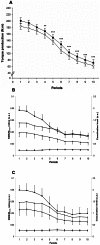Time course of the cross-over effect of fatigue on the contralateral muscle after unilateral exercise
- PMID: 23741417
- PMCID: PMC3669025
- DOI: 10.1371/journal.pone.0064910
Time course of the cross-over effect of fatigue on the contralateral muscle after unilateral exercise
Abstract
We investigated the cross-over effect of muscle fatigue and its time course on the non-exercising contralateral limb (NEL) after unilateral fatiguing contractions of the ipsilateral exercising limb (EL). For this purpose, 15 males performed two bouts of 100-second maximal isometric knee extensions with the exercising limb, and neuromuscular function of both the EL and NEL was assessed before (PRE), after a first fatiguing exercise (MID) and after a second fatiguing exercise (POST). Maximal voluntary isometric torque production declined in the EL after the first bout of exercise (-9.6%; p<0.001) while in the NEL, the decrease occurred after the second bout of exercise (-10.6%; p<0.001). At MID, torque decline of the EL was strictly associated to an alteration of the mechanical twitch properties evoked by neurostimulation of the femoral nerve (i.e., peak twitch torque, maximal rate of twitch development). According to these markers, we suggest that peripheral fatigue occurred. At POST, after the second bout of exercise, the voluntary activation level of the knee extensor muscles was altered from PRE (-9.1%; p<0.001), indicating an overall central failure in both the EL and NEL. These findings indicate that two bouts of unilateral fatiguing exercise were needed to induce a cross-over effect of muscle fatigue on the non-exercising contralateral limb. Differential adjustments of the motor pathway (peripheral fatigue vs. central fatigue) might contribute to the respective torque decline in the EL and the NEL. Given that our unilateral fatiguing exercise induced immediate maximal torque reduction in the EL and postponed the loss of torque production in the NEL, it is also concluded that the time course of muscle fatigue differed between limbs.
Conflict of interest statement
Figures




References
-
- Mosso A, Drummond M, Drummond WB (1906) Fatigue. London: New York: S. Sonnenschein, G. P. Putnam’s Sons. xiv, 334 p. p. Available: http://catalog.hathitrust.org/Record/007701583. Accessed 10 February 2013.
-
- Kennedy A, Hug F, Sveistrup H, Guével A (2012) Fatiguing handgrip exercise alters maximal force-generating capacity of plantar-flexors. Eur J Appl Physiol. doi:10.1007/s00421-012-2462-1. - DOI - PubMed
-
- Zijdewind I, Zwarts MJ, Kernell D (1998) Influence of a voluntary fatigue test on the contralateral homologous muscle in humans? Neurosci Lett 253: 41–44. - PubMed
-
- Zijdewind I, Kernell D (2001) Bilateral interactions during contractions of intrinsic hand muscles. J Neurophysiol 85: 1907–1913. - PubMed
-
- Todd G, Petersen NT, Taylor JL, Gandevia SC (2003) The effect of a contralateral contraction on maximal voluntary activation and central fatigue in elbow flexor muscles. Exp Brain Res 150: 308–313 doi:10.1007/s00221-003-1379-7 - DOI - PubMed
Publication types
MeSH terms
LinkOut - more resources
Full Text Sources
Other Literature Sources
Medical

